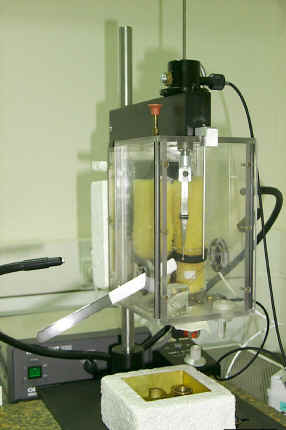The equipment is part of the Technion Center for Electron Microscopy of Soft Matter.
CEVS – Controlled Environment Vitrification System

The CEVS permits cryofixation of hydrated biological and colloidal dispersions and aggregates from a temperature- and saturation-controlled environment. Otherwise, specimens prepared in an uncontrolled laboratory atmosphere are subject to evaporation and heat transfer, which may introduce artifacts caused by concentration, pH, ionic strength, and temperature changes.
This system ensures that a liquid or partially liquid specimen is maintained in its original state while it is being prepared before vitrification and, once prepared, is vitrified with little alteration of its microstructure. A controlled environment is provided within a chamber where the temperature and chemical activity of volatile components can be controlled while the specimen is prepared.
Click here for a complete description of the improved sample preparation technique.
Leica Automatic Plunge Freezer EM GP2
The EM GP2 system vitrifies fluid or extremely thin samples spread on an electron microscopy grid by plunging into freezing ethane after removing excess fluid by automatic blotting.
The sample is maintained in a temperature- and humidity-controlled environmental chamber, adjustable between +4°C and +60°C, and room humidity to 99 % relative humidity. The entire procedure is automated.
Leica EM ICE, High-Pressure Freezing System

This “high-pressure freezing״ (HPF) system allows the thermal fixation of the specimens under high pressure to reduce freezing artifacts by ice crystal growth. Cooling is performed at high pressure (ca 200 bar) liquid nitrogen, thus liming ice nucleation and growth. This is most useful for cryo-SEM specimens that cannot otherwise be successfully cryo-preserved.
Leica EM ACE900 – Freeze-Fracture-Replication System

After thermal fixation, the specimen is mounted on the system liquid nitrogen-cooled stage (-175 ˚C), and it is fractured by a cooled knife at a 10-7 mbar vacuum chamber. The fractured specimen may be coated by carbon or chromium
For cryo-SEM, the sample is transferred immediately to the cold-stage of the SEM via an evacuated liquid nitrogen-cooled shuttle.
For freeze-fracture-replication, the fracture surface of the specimen is shadowed by Pt or Cr, and it is backed by a carbon layer. Metal and carbon coating is performed by two adjustable electron-sputtering guns. The coated sample is removed from the chamber, dissolved, the replica washed, dried, and then examined by TEM at room temperature.

